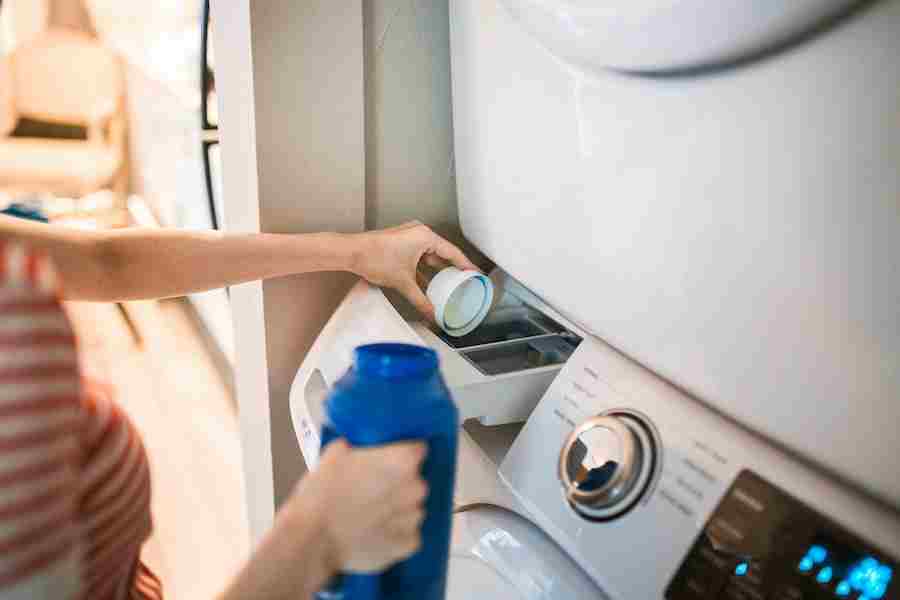Mixing bleach and laundry detergent is a topic that raises concerns about potential dangers and chemical reactions. It is crucial to understand the risks involved when combining these two substances, as the consequences can be harmful to both human health and the environment. This article aims to shed light on what happens when bleach and laundry detergent are mixed, exploring the chemical reactions that occur, the health risks associated, and the safety precautions to be followed. By gaining knowledge about this topic, individuals can make informed decisions and protect themselves from potential hazards.
What Happens If You Mix Bleach And Laundry Detergent?
When bleach and laundry detergent are mixed, several chemical reactions can occur, leading to potentially harmful consequences. The specific reactions depend on the ingredients present in the bleach and detergent, but some common reactions include:
- Release of toxic gases: Certain laundry detergents contain ammonia, and when mixed with bleach, it can produce toxic gases, such as chlorine gas. Chlorine gas can cause severe respiratory distress, coughing, and chest pain, and in extreme cases, it can be fatal.
- Reduced effectiveness: Mixing bleach and detergent can neutralize the cleaning power of both substances. This can result in reduced stain removal and disinfection capabilities, rendering your cleaning efforts less effective.
- Skin and eye irritation: The chemical reactions that occur when bleach and detergent are mixed can release irritants that can cause skin and eye irritation. Direct contact with the mixture may result in redness, itching, a burning sensation, and even chemical burns.
- Formation of harmful byproducts: Some detergents contain chemicals that, when mixed with bleach, can produce harmful byproducts. For example, mixing bleach with detergents containing certain fatty acids can result in the formation of chloroform, a potential carcinogen.
The Ingredients And Functions Of Laundry Detergent
Laundry detergents are specifically formulated cleaning agents designed to remove dirt, stains, and odors from fabrics during the washing process. They contain a combination of various ingredients, each serving a specific function. Here are three main categories of ingredients found in laundry detergents:

Surfactants, short for surface-active agents, are the key cleansing agents in laundry detergents. They help to loosen and remove dirt, oils, and stains from fabric fibers by reducing the surface tension of water. Surfactants work by breaking down the oily or greasy substances that bind dirt to fabrics, allowing them to be washed away during rinsing. Common surfactants used in laundry detergents include anionic surfactants (such as linear alkylbenzene sulfonates or LAS) and nonionic surfactants (such as alcohol ethoxylates).
Builders are additives in laundry detergents that enhance the cleaning performance by softening water and controlling mineral deposits. Hard water, which contains high levels of minerals like calcium and magnesium, can reduce the effectiveness of surfactants. Builders, such as phosphates or zeolites, help to bind with these minerals, preventing them from interfering with the cleaning process. Additionally, builders can also aid in removing stains and improving the overall efficiency of the detergent.
Many laundry detergents contain enzymes and other additives to enhance stain removal and address specific cleaning needs. Enzymes, such as proteases, amylases, and lipases, target specific types of stains like protein-based stains, starches, and greases respectively, breaking them down for easier removal. Additionally, detergents may include additives such as optical brighteners, which help make fabrics appear brighter by absorbing UV light and re-emitting it as visible light. Fragrances may also be added to provide a pleasant scent to freshly washed clothes.
Health Risks And Safety Precautions
Mixing bleach and laundry detergent can pose several health risks. Some of the potential dangers include:
- Respiratory issues: The release of toxic gases, such as chlorine gas, can cause respiratory distress, coughing, shortness of breath, and even lung damage. Prolonged exposure to these gases can be particularly harmful to individuals with respiratory conditions like asthma or chronic obstructive pulmonary disease (COPD).
- Skin and eye irritation: The mixture of bleach and detergent can lead to skin and eye irritation. Direct contact may result in redness, itching, burning sensations, and in severe cases, chemical burns. People with sensitive skin or pre-existing skin conditions may be more susceptible to these effects.
- Allergic reactions: Some individuals may be allergic to the chemicals present in bleach or laundry detergent. Mixing the two substances can potentially trigger allergic reactions, ranging from mild symptoms like hives and itching to severe anaphylaxis, which requires immediate medical attention.
How To Safe Handling And Proper Use?
- Read and Follow Instructions: Always read and follow the instructions provided on the labels of bleach and laundry detergent. Pay attention to any warnings, precautions, or recommended usage guidelines.
- Ventilation: Ensure proper ventilation in the area where you are using bleach or laundry detergent. Open windows or use fans to circulate fresh air and prevent the build-up of fumes.
- Protective Gear: Wear protective gear, such as gloves, goggles, and a mask, when handling bleach or detergent. This will help protect your skin, eyes, and respiratory system from potential chemical exposure.
- Dilution: If dilution is necessary, follow the recommended dilution ratios provided by the manufacturer. Avoid adding excessive amounts of bleach or detergent as it can be harmful and reduce effectiveness.
- Separate Usage: Use bleach and laundry detergent separately for different cleaning tasks. Do not mix them together, even in small amounts, to avoid chemical reactions and potential hazards.
- Storage: Store bleach and laundry detergent in their original containers, tightly sealed, and in a safe location away from children and pets. Follow the manufacturer’s instructions regarding proper storage conditions.
- Disposal: Dispose of empty bleach and detergent containers properly, following local guidelines for hazardous waste disposal. Do not reuse empty bleach containers for other purposes.
- Test for Compatibility: Before using bleach or detergent on a new surface or fabric, perform a patch test to ensure compatibility and avoid any potential damage or discoloration.
- Clean-Up Spills: In the event of a spill, immediately clean it up using appropriate protective gear. Dilute the spill with water and absorb it with disposable towels or absorbent materials. Dispose of the contaminated materials properly.
- Keep Out of Reach: Keep bleach and laundry detergent out of reach of children and pets to prevent accidental ingestion or exposure.
By following these guidelines for safe handling and proper use, you can minimize the risks associated with bleach and laundry detergent, ensuring a safe and effective cleaning process. Remember, your health and safety should always be a priority when working with cleaning chemicals.
Alternative Cleaning Methods
- Natural Cleaning Agents: Harness the power of vinegar, baking soda, and lemon juice for various cleaning tasks. These natural ingredients can be used to remove stains, eliminate odors, and disinfect surfaces.
- Hydrogen Peroxide: Utilize hydrogen peroxide as a safe and effective alternative to bleach. It can be used as a disinfectant, stain remover, and mold/mildew cleaner.
- Eco-Friendly Cleaning Products: Opt for environmentally-friendly cleaning products that are specifically formulated to be effective without the use of harsh chemicals. Look for labels indicating biodegradable, non-toxic, and plant-based ingredients.
- Steam Cleaning: Invest in a steam cleaner to tackle a wide range of cleaning tasks, including sanitizing floors, upholstery, and appliances. Steam effectively kills bacteria and removes dirt without the need for additional cleaning agents.
- Microfiber Cloths and Mops: Replace traditional cleaning tools with microfiber cloths and mops. These reusable and highly absorbent materials require minimal or no cleaning solutions while effectively trapping dirt and bacteria.
By exploring these alternative cleaning methods, you can maintain a clean and healthy environment while minimizing the risks associated with mixing bleach and laundry detergent.
Summary
Understanding the risks and following safety precautions is vital to protect your health and the environment. By prioritizing proper handling, ventilation, and wearing protective gear, you can minimize the health risks associated with these substances. It is crucial to use bleach and detergent separately, as directed, and to dispose of them properly. Prioritizing safety ensures effective cleaning while safeguarding your well-being.
FAQ’s
Can I Mix Bleach And Laundry Detergent If I Dilute Them With Water?
No, diluting bleach and laundry detergent with water does not eliminate the risks associated with mixing them. Chemical reactions can still occur, releasing toxic gases and potentially causing harm. It is best to avoid mixing them altogether.
Can I Mix Any Type Of Detergent With Bleach?
No, not all detergents are compatible with bleach. Some detergents contain ingredients, such as ammonia or acids, that can react with bleach and produce toxic gases. Always read the detergent labels and avoid mixing them with bleach unless specifically recommended by the manufacturer.
What Should I Do If I Accidentally Mix Bleach And Laundry Detergent?
If you accidentally mix bleach and laundry detergent, it is important to take immediate action. Move to a well-ventilated area and avoid inhaling the fumes. If the mixture comes into contact with your skin or eyes, rinse thoroughly with water. If any adverse symptoms persist or worsen, seek medical attention.
Can Mixing Bleach And Laundry Detergent Enhance Disinfection?
No, mixing bleach and laundry detergent does not enhance disinfection. Bleach on its own is a powerful disinfectant, capable of killing many harmful pathogens. Following proper usage instructions, including appropriate contact times and dilution ratios, is sufficient for effective disinfection.
What Are Some Alternative Cleaning Methods That Don’t Involve Mixing Bleach And Laundry Detergent?
There are several alternative cleaning methods that don’t involve mixing bleach and laundry detergent. Some options include using natural cleaning agents like vinegar and baking soda, using hydrogen peroxide as a disinfectant, or using specific cleaning products designed for different purposes. These alternatives can provide effective cleaning without the risks associated with mixing bleach and laundry detergent.





